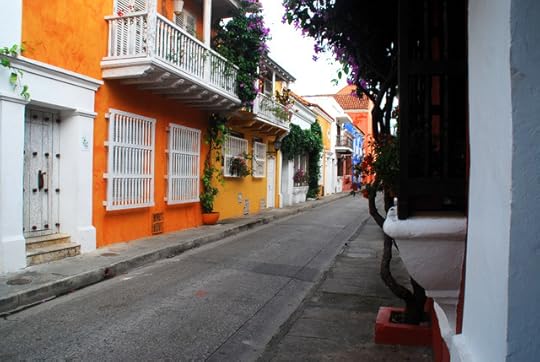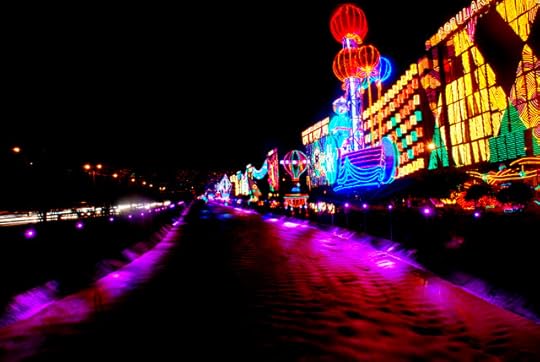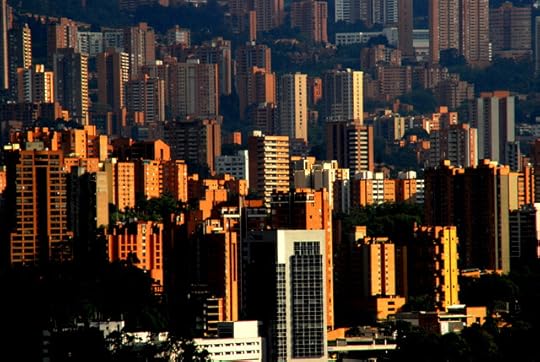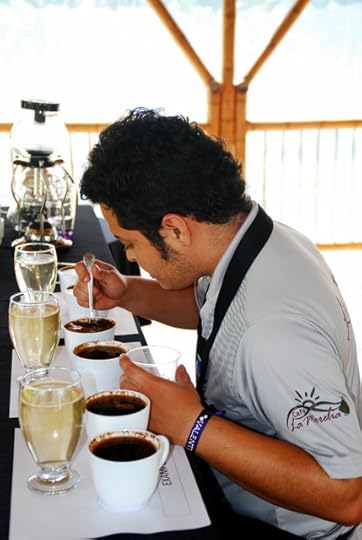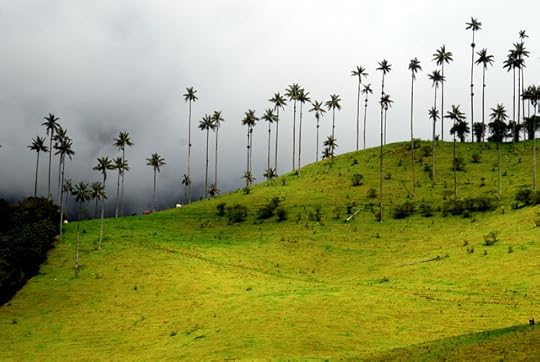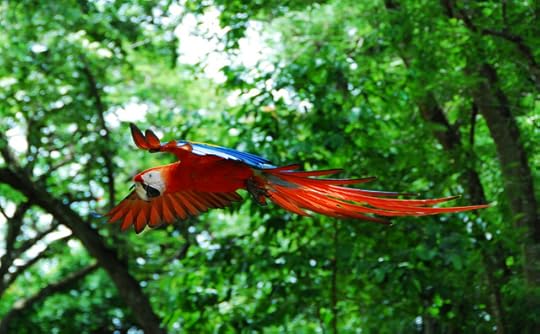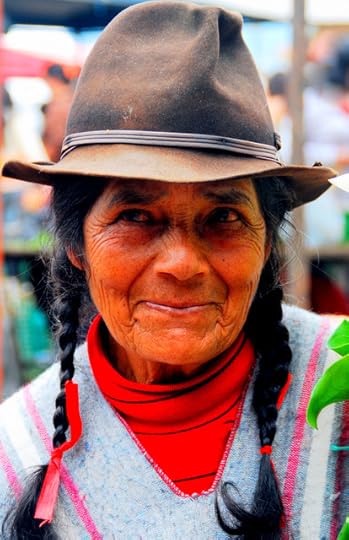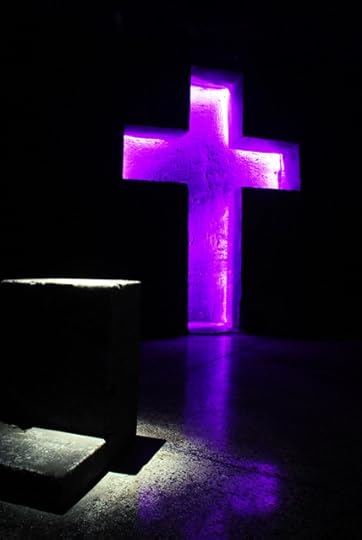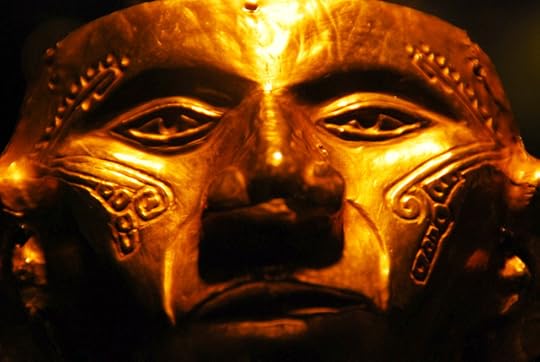Roderick Phillips's Blog, page 20
January 14, 2014
Medellin to Cartagena, Day 170
Before we leave Medellin for Cartagena, our last destination in Colombia and South America, there may just be time to get the dreaded laundry done. It’s almost an embarrassment now to give our faded, grungy unmentionables to the lavendaria, Clean and Clean – let alone expect them to have our freshly laundered clothes returned to us by noon today. Indeed, the owner of Clean and Clean shakes his head vigorously initially, but as I repeatedly improve my offer the shaking reluctantly becomes a nod. We do the deal for US$30. Now that we’ve spent all our money on the laundry, Christi and I have a great excuse for relaxing in our very expensive hotel room at the Park 10 and completing the usual chores of diary writing, editing photos, and confirming onward travel arrangements. Our time in South America is drawing to a close and the Dark Continent of Africa looms ever larger on the horizon. And travel in Africa will be considerably more problematic than the relative ease with which Christi and I have floated gently around South America. For this reason, if no other, a relaxing few days in Cartagena seems like a good idea ahead of a long campaign in Africa.
Clean and Clean are a little reluctant to return our laundry at noon, but it comes eventually and it is wonderfully clean. Phew! Pack rather in a rush and leave the comforts of the Park 10 for Medellin’s Jose Maria Cordova International Airport. In fact, the transfer takes almost as long as the 40-minute flight! It’s only 294 miles from Medellin to Cartagena but they are pesky mountain miles, which would otherwise take 13 hours by bus. I don’t think either Christi or I could face that kind of bus journey again. Our flight takes us out of the Andes for the very last time and back to the hot and humid conditions we encountered on Margarita Island, only now we are in one of the jewels of South American tourism – the historic town of Cartagena on the shores of the Caribbean sea.
Our hotel, the Casa Veranera, sends a car to meet us from the airport – so different from our nervous arrival in Quito 6 months ago when we mangled the spanish language to get a taxi into town. The staff at the Casa Veranera are very friendly – Colombia is a very friendly place – but our room is odd. There is a living room with no air-conditioning (and boy do you need air-conditioning in this town) facing a glass-fronted shower and toilet. The bathroom has no curtains and hence no privacy. Doing one’s business is now a spectator sport, unless all the spectators leave the living room. The bedroom does have air-conditioning, but no door. The bedroom also has stairs leading to a roof-top balcony, which means the exterior humidity and interior cool air clash right over the bed, creating stormy conditions as one person freezes and the other sweats. This has got to be the weirdest place we’ve stayed in. I can’t even begin to imagine what the designer had in mind when he created this aesthetic.
We escape the weirdness and begin exploring Cartagena, a laid-back town with surprisingly few tourists at the moment. Cartagena Old Town is one of the best preserved colonial towns in South America, while the modern city sprung up around it and now dwarfs it.
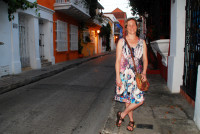
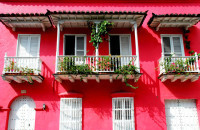

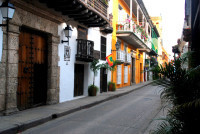
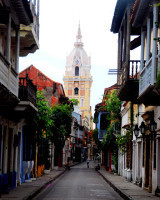
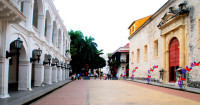
Blog post by Roderick Phillips, author of Weary Heart – a gut-wrenching, heart-wrenching, laugh-wrenching tale.
The post Medellin to Cartagena, Day 170 appeared first on Roderick Phillips.
January 13, 2014
Festival of Lights, Medellin, Day 169
The best time to see the Festival of Lights is, of course, at night, which gives Christi and I the whole day to explore Medellin. We decide to explore on foot, although whether this is a good idea is debatable. Indeed, few pedestrians are out and about (plenty of traffic, though) as we walk along calle 10 and the Milla de Oro (the Golden Mile – carrera 43a), which is the Rodeo Drive of Medellin. As we look for lunch options among the numerous malls we see plenty of Western-style fast-food options, including Dominos Pizza, KFC, and McCafe (McDonald’s) none of which are particularly appealing. We eventually settle on a sports bar called Bernaveu Brasas Pasion y Futbol, which proudly displays a Chelsea FC flag.
Medellin is a sufficiently large city to have a metro system (which predominantly runs north-south) and we take a train from Poblado metro station to Industrales one stop to the north. The Lonely Planet is not richly endowed with things to do in Medellin other than the Festival of Lights and shopping, but one place that is mentioned is Cerro Nutibara. This hilltop, located in the center of town, provides grand views of the city and is also home to a replica historical Antioquian village (Medellin is situated in the state of Antioquia) called Pueblito Paisa. The village would not look out-of-place in Disneyland, as historical authenticity plays second fiddle to crass consumerism. In addition to a church and a central plaza with fountain there is a fairly impressive museum, but most of the remaining facades hide a souvenir shop, bar, or restaurant. It’s cold and wet and we drag out our hot chocolate and pastries as long as possible, waiting for sunset when down below us, along the Rio Medellin, the Festival of Lights will magically transform this drab winter’s day (technically most of Colombia and Venezuela are in the Northern Hemisphere) into a kaleidoscope of color.
At 6 pm the Festival of Lights begin and we scurry back down the hill and join the rest of the Medellin folks in marveling at the light show. For more than a mile beside the Rio Medellin themed displays dazzle the route: Santa Claus, lanterns, helicopters, balloons, flying machines, religious scenes, flowers, Christmas trees etc. sparkle in our wandering eyes. Most of Medellin must have been there because the area is packed with excited and enthusiastic Paisas (as the locals are known). Endless food vendors, souvenir stalls, hawkers, and street entertainers ensured there was never a dull or hungry moment. The weather even cooperated so we all stay dry. Christi and I had a magnificent night exploring the milla de Oro of lights. Thank you Medellin.
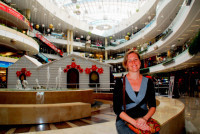




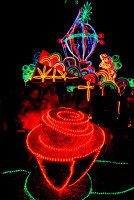

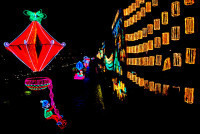
Blog post by Roderick Phillips, author of Weary Heart – a gut-wrenching, heart-wrenching, laugh-wrenching ride.
The post Festival of Lights, Medellin, Day 169 appeared first on Roderick Phillips.
January 12, 2014
Armenia to Medellin, Day 168
The end to another brief taste of luxury. Christi and I say goodbye to the Hacienda Bambusa and rejoin the backpacker world for the 7-hour semi-cama bus ride aboard the Flota Occidental service to Medellin. Of all the drug-related stories in Colombia, those involving the Medellin Cartel are perhaps the most savage and infamous and I travel with a feeling of apprehension…
As the crow flies it’s only about 125 miles from Armenia to Medellin, but this barely begins to describe our journey. The Zona Cafetera is wedged between the Cordillera Occidental and the Cordillera Central, which means lots of steep hills – up and down. And beyond the town of Pereira (20 miles to the north of Armenia), the two-lane dual carriageway becomes single lane traffic. Double yellow lines down the center of the road mark the entire route and are completely ignored. Aside from buses, there are cars, huge numbers of annoying motorcycles buzzing in and out of the traffic, and worst of all, large slow-moving trucks. Everyone wants to get to their destination first so it’s a crazy free-for-all on the roads. And we have front row seats, which is not for the faint-hearted as the bus driver repeatedly hurtles passed slower-moving vehicles and especially so on blind corners. Quite how we don’t crash is beyond me.
Having said that the ride is through some spectacular cultivated scenery. Even in slopes that are almost sheer, the locals grow coffee and plantains/bananas. At the base of the largest gorge we cross, the river (the Rio Cauca) has begun to flood parts of the town (La Pintada) yet less than a mile from the affected area, people are casually drinking coffee in outdoor cafes. Perhaps it’s only foreigners who are shocked by the flooding. Perhaps it’s a common event in this part of the country. Although this begs the question: why continue to live in a section of town that is at high risk of flooding. Yet again Colombia baffles me.
Medellin is a city of tower blocks. Lots and lots of ugly tower blocks with an equally ugly river, the Rio Medellin, running through the center of town. But at night at this time of year, this riverfront area is transformed for the Festival Of Lights. Although many cities in Colombia put on a show, Medellin has the most spectacular festivities – which is why Christi and I risked the wrath of the cocaine barons to attend.
I know we agreed to stay in slightly nicer accommodation in Colombia, but the quality has jumped alarmingly. And the Park 10 Hotel in the El Poblado section of Medellin is no exception. Our split-level room is spectacular. There is a downstairs living room with sofas, dining table, TV, bar and toilet and an upstairs bedroom with sitting room and a huge bathroom! Perhaps Christi has finally got tired of the backpacker lifestyle. I don’t complain – it’s hard to argue against a little luxury now and again – but we are not even half way through our Year of Wonder and we didn’t have that much money to begin with. I tentatively raise the subject, but Christi assures me our budget has not been decimated. So where is the money coming from? Why do we suddenly have lots of money to spend in Colombia? The answer…tomorrow!
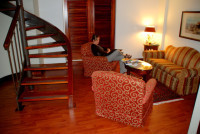
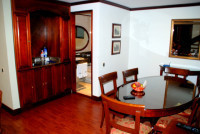

Blog post by Roderick Phillips, author of Weary Heart, a gut-wrenching, heart-wrenching, laugh-wrenching story.
The post Armenia to Medellin, Day 168 appeared first on Roderick Phillips.
January 11, 2014
Cafe la Morelia, Zona Cafetera, Day 167
Cafe la Morelia is an authentic, traditional plantation some 30 minutes ( by rented car – ching!) from the Hacienda Bambusa. Have you ever noticed at fancy restaurants and fancy hotels that nothing is free. Everything is available but always in addition to the already huge sums of money being paid to eat / stay there. I am a conflicted backpacker – or maybe I’m just cheap! Our English-speaking guide to cafe la Morelia is Juan. He learned English during a hot summer spent in the English seaside town of Bournemouth. I didn’t have the nerve to ask whether ‘hot’ referred to the girls or the weather, although I’d never really associated either with Bournemouth. I’m babbling; let’s get back to the story. We begin our tour of café la Morelia in the fields looking at the coffee plants themselves. The elevation (1260m) supports the caturra variety of coffee bean and currently 40 hectares are devoted to growing it. The remaining 30 hectares are given over to other cash crops such as plantain, which provide most of the income necessary to support the coffee business.
I’m not much of a coffee drinker, but Christi is fascinated by the details: coffee beans are picked when they are red (green beans are not yet ripe). The beans then go through a series of processing steps to remove the skin and sugary coating before being dried and sized. According to Juan, small/medium-sized beans make the best/gourmet coffee, while the larger beans are used to make traditional coffee. Before the beans are roasted they are further sorted to remove contaminated beans (bitten by insects) wrong size, or other defects. Next the beans are roasted for about 15-minutes to provide the dark color and correct texture. A pound of ground gourmet coffee costs COP$14,000 (US$7). By comparison the lowly coffee bean picker earns COP$6,000 (US$3) per gallon of beans picked, although food and accommodation at cafe la Morelia is included. Most pickers are only employed for the two major coffee bean harvests (Mar-May and Oct-Dec), however, so it’s a precarious life.
Finally we get to the serious bit: drinking the damn stuff. Sebastian is the guardian of taste and quality at Cafe la Morelia. Christi is in her element here as she follows Sebastian in snorting, slurping, and savoring several examples of coffee prepared on the plantation. Coffee is definitely not my thing and the samples I try all taste rather bitter to me. Still it’s a fantastic tour and we’re given a souvenir bag of goodies, including coffee, as we leave. I try to repay the favor by tipping Juan, but he refuses it; says it is unnecessary. I don’t think I’ve ever met anyone who has refused a tip before. Colombia truly is a unique country.
After lunch back at Hacienda Bambusa, Christi and I finally explore the plantation. The owner of the plantation, Camilla, explains that here is a 3-mile round trip to a viewpoint, which will still get us back to the Hacienda in time for afternoon tea (or in Christi’s case, coffee). I guess the thing about luxury is that you never have to exert yourself or stress out overly. No doubt it’s possible to pay someone to do that on your behalf. Christi and I therefore enjoy a leisurely stroll (even the word hike sounds too arduous) through rolling farmland rich with exotic flowers plus stands of banana, papaya, and oranges to a beautiful viewpoint over the valley below, replete with river and more farms. We also spot some bizarre cows with rather large ears and a pendulous, flapping dewlap. Apparently both of these features are adaptations used to dissipate heat, and, boy, is it humid here (another reason to amble along gently). Not only do we make it back to the hacienda in time for afternoon tea, but we also manage a siesta before dinner. Now this is traveling!
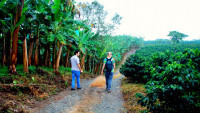



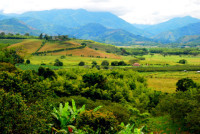
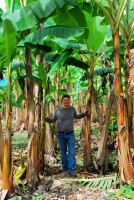
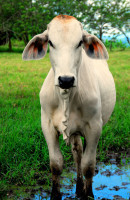

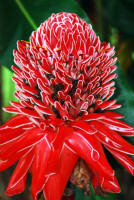
Blog post by Roderick Phillips, author of Weary Heart – a gut-wrenching, heart-wrenching, laugh-wrenching tale.
The post Cafe la Morelia, Zona Cafetera, Day 167 appeared first on Roderick Phillips.
January 10, 2014
Valle de Cocora, Day 166
One of the things to do in Colombia is to hike Valle de Cocora. This valley, located in the department of Quindio in the Central Cordillera of the Andes mountains, is home to the rare Quindio wax palm, which is the national tree of Colombia. These lanky, spindly trees are actually the tallest palm trees in the world, reaching heights of 60 m. Much like the Coastal Redwoods of North America, these wax palm trees only inhabit a very specific habitat, namely the western slopes of the Andes between 8-9,000 feet. Furthermore, these very slow-growing trees exist in a symbiotic relationship with the endangered yellow-eared parrot. In return for shelter and food, the parrot fertilizes and disperses the wax palm seed. It’s a complex and delicate ecosystem and not surprisingly in this modern world one that is under extreme pressure. Fortunately the Colombian government managed to divert a little attention away from the cocaine wars to add Valle de Cocora to the existing Los Nevados National Natural Park in 1985, thus according the tree and the parrot protected status. One can only hope the yellow-eared parrot does not go the same way as its distant cousin, the norwegian blue!
Actually getting to Valle de Cocora as Colombia continues to suffer from flooding of biblical proportions is a challenge, but as usual throw enough money at the problem and someone will risk the mudslides and water slides to take us where we want to go. Of course we may need to take out a second mortgage at this rate of spend!
Unlike wildlife, the wax palms cannot hide so they are pretty easy to spot (standing tall and elegant against dazzling green slopes of the valley) once we reach the tiny community of Cocora some two hours after leaving the Hacienda Bambusa. Despite the advice of the locals to use horse, Christi and I elect to hike on foot. Perhaps it’s more accurate to say that the prospect of getting on the back of a horse for the first time in my life was too scary to contemplate. It was, of course, completely the wrong decision. We brought hiking shoes and sandals, but what we really need are waist-high waders to have any hope of negotiating the feces-infused quagmire of a trail that stretches out before us. The trail, squeezed between private property and marked by barbed wire, resembles a jagged scar carved into the otherwise verdant slopes. Having come this far, though, we have to at least try to hike. We cling to a thin sliver of grass beside the sodden trail tight against the barbed wire fence for 90-minutes making slow, clumsy progress. Neither of us are too thrilled with the hike, although the abundant wax palms keep us company. A party of tourists on horseback comes hurtling through the mire at one point, churning up more mud and feces and we scuttle to the edge of the trail to avoid flying hoofs and flying poo.
We hike for a total of 3 slippery hours, the last 30-minutes in pouring rain, which puts it right up there with Day 2 of our Roraima trek and the tour of Rio for sheer entertainment value. The atrocious weather continues until we reach the Hacienda Bambusa where, as sod’s law would have it, the weather has been perfect all day. The bath tub takes a beating as we try to clean up, but at least we have hot water, and we are eventually rewarded with another excellent dinner.
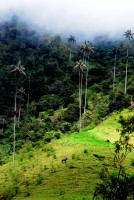
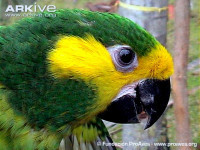
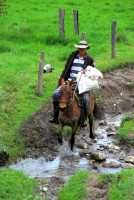
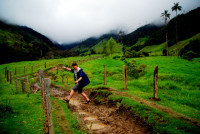
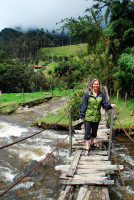
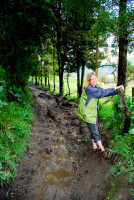
Blog post by Roderick Phillips, author of Weary Heart – a gut-wrenching, heart-wrenching, laugh-wrenching story.
The post Valle de Cocora, Day 166 appeared first on Roderick Phillips.
January 9, 2014
Armenia, Colombia, Day 165
Our stay in Bogota this time is brief and today we’re off to Armenia in the Zona Cafetera. The Zona Cafetrea is the major coffee growing region in Colombia. It’s one of those destinations which takes an hour to reach by plane and 16 tortuous hours by bus. The reason being the Zona Cafetera is on the eastern side of the Andes (while Bogota is located on the western slopes). Indeed at 8,500 feet above sea level, Bogota is at a similar elevation to Quito (Ecuador) – another sign that we’ve come full circle on this tour of South America.
There are dark clouds and abundant rain at Bogota airport, delaying our flight to Armenia. Even when we do finally take off it’s not for the faint hearted. There is a lot of turbulence over the Andes and our little Avianca plane is buffeted quite mercilessly. Fasten those seat belts and hold on tight! We learn later that owing to the ongoing flooding, flying is the only reliable way to cross the Andes at the moment as the roads are often impassable.
Armenia is much more tropical (and consequently hotter and more humid) than Bogota. A complimentary car meets us at the airport and Christi and I are taken on a 30-minute drive through ever worsening roads to the rustic and idyllic Hacienda Bambusa. We’ve loosed the purse strings again as our true desire for luxury living shines forth. Indeed, there seems more staff than guests here. Our room is a little bare, but the bed is very comfortable. There is also a surprisingly large closet and endless hot water. We have a wrap-around deck with comfy chairs and beautiful views of lawns, gardens and a swimming pool stretching out to lush verdant mountains. The Hacienda is in the middle of a working plantation and banana, coco, oranges and ginger are among the crops cultivated. There is also abundant, colorful birdlife such as macaws, ibis, and egrets. We arrange a few expensive excursions and then mostly relax on our deck, watching the monsoon. For once, though, the rain doesn’t matter. Dinner is of course sumptuous. It appears that having lots of money (which we really don’t) can make your life easier and better!
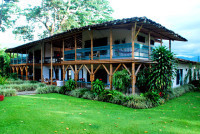
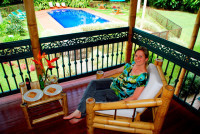

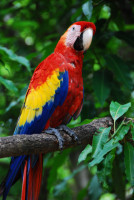
Blog post by Roderick Phillips, author of Weary Heart – a gut wrenching, heart-wrenching, laugh-wrenching tale.
The post Armenia, Colombia, Day 165 appeared first on Roderick Phillips.
January 8, 2014
Villa de Leyva, Colombia Day 164
A little ways outside of Villa de Leyva is a scenic viewpoint overlooking the town. It requires a modest hike, which Christi feels I am more than capable of accomplishing on my own. ”You have, after all, completed the Inca trail and the Roraima trek,” she points out. While Christi does something far less energetic, I slosh through muddy pools and stumble on slick hillsides until more by luck than judgement I find a suitable spot to take some shots. By this point, however, thick dark clouds have rolled in, but such is my commitment to taking the perfect image that I wait patiently – for more than an hour – for a suitable break in the clouds. Alas, there is no Kodak moment and I ‘m left with some dull cityscape shots instead brochure-quality sun-drenched images. Saturday is a busy day in Villa de Leyva. First, there is a wonderful market: fruit, vegetables, potatoes, clothes, cooked dishes and no tourist crap. There’s plenty to photograph including more of the indigenous Musica. Second there is a wedding (in the rain) in the local parish church on the east of Plaza Mayor. Christi and I almost become part of the ceremony as we nip in through the open doors for a quick peek. We watch the bride arrive in a horse-drawn carriage from a café on the north side of the square. I can’t resist the urge for a few photos and dash out into a wet and windy plaza to capture the moment. The driver of the carriage even poses for a few shots.
Sadly, it’s time to leave Villa de Leyva and return to Bogota. Hasiento wants to return via Chiquinquira, the religious capital of Colombia. It’s fame arises from a miracle that supposedly occurred here in 1586 when a decrepit painting of Mary, the Virgin of Chiquinquirá, was miraculously restored to its former glory. Word of the miracle got around and flocks of pilgrims have visited over the centuries, including Pope John Paul II in 1986. The painting is believed to be the oldest in Colombia, dating to 1555. The artist is a Spaniard called Alonso de Narvaez. His painting, which is once again faded and decrepit, sits above the high altar of the Basilica de la Virgen de Chiquinquira behind protective glass no doubt waiting for yet another miracle to restore it to its former beauty.
The road back to Bogota is wretched with trucks and Hasiento does some crazy driving to get us back to the capital. Flooding continues to be a problem and a major road into the city is lined with sandbags to keep it open. Although Christi thoroughly enjoyed her stay at the Hotel de la Opera, she wants to try a new place tonight – the Abadia Colonial. The floor of our room is covered in pink rose petals, which is rather romantic, although quite why the staff think Christi and I are deserving of such special treatment is unclear. Colombia really is a very friendly place!
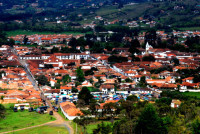
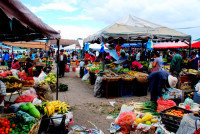
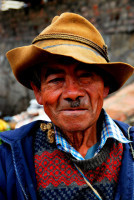
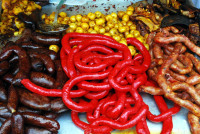
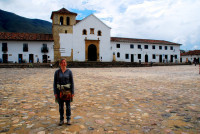
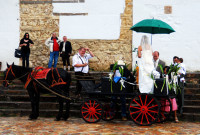
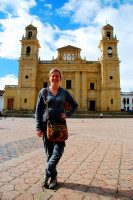

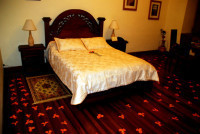
Blog post by Roderick Phillips, author of Weary Heart – a gut-wrenching, heart-wrenching, laugh-wrenching tale.
The post Villa de Leyva, Colombia Day 164 appeared first on Roderick Phillips.
January 7, 2014
Raquira, Colombia, Day 163
The day dawns with beautiful skies and we can’t wait to begin exploring the area beginning with Villa de Leyva, then Raquira, and if there’s enough time, the Monasterio de la Candelaria. After a complimentary breakfast at the Posada de San Antonio, we walk the cobbled streets of colonial Villa de Leyva. The Plaza Mayor is a vast open space with little development. The east is the main church, Iglesia Parroquial, while the other three sides are cafes, hotels, and museums.
Much like the rest of Colombia, the town is very clean, the people are very friendly and no one hassles us. It’s great. There are many dogs wandering around, but the townsfolk appear to take care of them (and we helped by feeding one last night). The only blight as far as I’m concerned is the abundance of vehicles, which clog the narrow streets. We poke around the back streets of Villa de Leyva all morning, until the rain returns.
In the afternoon (with the deluge continuing) we ask our guide, Hasiento, to take us to Raquira, the City of Pots. He clearly has never been to this artisnal mountain community before because he stops repeatedly to ask for directions. Raquira truly is a one street town that opens into a picturesque square. The most appealing aspect of the place are the brightly colored buildings, which make the town very warm and welcoming despite the rainstorm. As we huddle out of the rain amid some of the stores that face the plaza, Christi acquires a new friend, a local dog who wants a cuddle. Meantime, I persuade one of the local indigenous women, a Muisca to allow me to photograph her. With little improvement in the weather, we move to more comfortable accommodation, a nearby and very eclectic restaurant, which boasts chairs in the shape of crosses and large bug figures covering the ceiling. It was an odd place to watch the world go by. Raquira is actually the pottery capital of Colombia and every kind of tourist trinket is available, including clay pots of every dimension and any number of cute figures, although the slutty pigs do push the concept of good taste to the limit. Even the church is brightly painted, while clay figures – agricultural to religious line the square. Under thunderous clouds and diminishing light I run around and photograph whatever I can.
The next stop is the even more remote Monasterio de la Candelaria – another place that wows us and Hasiento. The monastery will close in 30 minutes, so we get the whistle-stop tour in high-speed Spanish. We understand about 25%, which isn’t bad. In addition to the monastery, itself, there are pretty gardens, a library with some very large books, a museum of animals, money and fossils, and lots of original artwork. Our guide allows me to photograph everything (despite the no photography signs!). The monastery was founded in 1597 and completed in 1660. The monk in charge supposedly lived to be 105.
Back in town, Christi and I eat dinner (trout and pork) at the Lonely Planet recommended Antique restaurant. We virtually have the place to ourselves, so maybe the backpackers go elsewhere! Live music was also provided and the singer serenaded us with the lovely ! Finish our meal in front of a roaring fire. De-lightful.

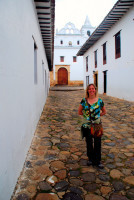

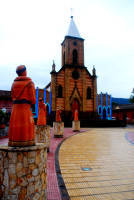
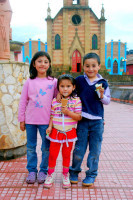
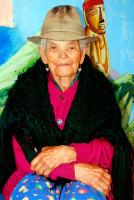


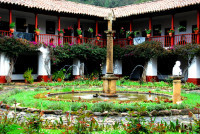
Blog post by Roderick Phillips, author of Weary Heart – a gut-wrenching, heart-wrenching, laugh-wrenching tale.
The post Raquira, Colombia, Day 163 appeared first on Roderick Phillips.
January 6, 2014
Zipaquira, Colombia, Day 162
The weather changes today and not for the better. We are sad to leave the luxury of the Hotel de la Opera, which is undoubtedly one of the more luxurious hotel experiences we’ve had in South America. Still tavelers must travel, although we are cheating a little. We’ve hired a car and driver to cover a few sites of interest immediately to the north of Bogota over the next few days. The first of these is Zipaquira, or more accurately the underground salt cathedral which gives the town it’s fame. Our driver / guide, Hasanito, keeps up a constant chatter as he drives along, but at he only speaks Spanish he’s basically talking to himself. I catch the odd phrase, including the fact that a nearby castle was once owned by the legendary drug smuggler Pable Escobar. It’s now a museum.
It’s actually a pleasant drive once we escape Bogota. As usual, the driving (including by our own guide) is a little cavalier and there are the obligatory pollution-belching lorries, while cows graze by the side of the road (tethered to avoid escape), dogs scurry past eager to reach their destination, while poncho-clad locals dodge the incessant rain drops.
For a country that is still developing it’s tourist infrastructure, the number of English tours available is quite remarkable, including the Salt Cathedral. Salt mining was and remains big business in Colombia. And since mining is dangerous and the locals are very religious it’s not surprising that small altars began to crop us, leading eventually to the formation of an underground cathedral. Active mining has moved to a different seam, allowing tourists like Christi and I to visit. The vast underground tunnels now have Stations of the Cross carved in salt and have been illuminated in ever-changing colored lights. The main cathedral chamber can accommodate over 8,000 worshippers and services are held on Sunday. Easter plays to packed houses. The altar is made of salt also and the major cross (15m tall) is carved into the rock face.
During the 3-hour drive to our next destination (the classic colonial town of Villa de Leyva), we get to see at first hand what months of rain has done to the countryside: many fields are flooded and sandbags even line some of the roads. We pass by a Disneyesque Parque Jimaine Duque with surreal castles and a mosque-like edifice dominating the theatre. Hasanito kindly stops at Puente de Boyaca. This is the battlefield where, on Aug 7th 1819, Simon Bolivar defeated the Spanish and brought freedom to Colombia. There’s a small bridge across which the Colombians marched to engage the Spanish, an eternal flame, and a statue of the great man himself who certainly does get around. We finally arrive in Villa de Leyva under blue skies near sunset. We are once again staying in a charming colonial hotel, La Posada de San Antonio, which even comes with complimentary cocktails!
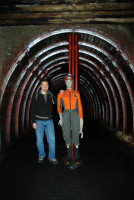
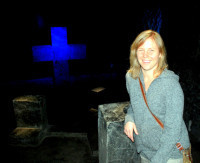
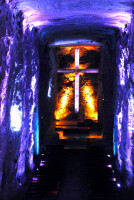
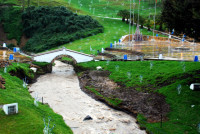

Blog post by Roderick Phillips, author of Weary Heart – a gut-wrenching, heart-wrenching, laugh-wrenching ride.
The post Zipaquira, Colombia, Day 162 appeared first on Roderick Phillips.
January 5, 2014
Museo del Oro, Bogota, Day 161
Stumble out of bed at 8:30 am and enjoy a complimentary breakfast of cereal, fresh juices and all manner of Colombian delicacies at the Hotel de la Opera. I could seriously get used to this lifestyle – if some one else was paying!
Despite dire weather predictions it’s another nice day in Bogota. As we walk around the downtown area, the vibe is very upbeat. The people seem confident and they dress in chic, elegant clothing. Bogota reminds me of a European city aside from the graffiti which is everywhere. The only city I’ve visited which had comparable levels of graffiti is Berlin – and that was before the wall came down. Bogota is very different from the derelict cocaine-snorting capital I’d been expecting. Our first destination is the Museo del Oro, the gold museum. The museum is truly stunning and, for once, understandable, as descriptions of the exhibits are provided in English as well as Spanish. There is even an audio guide in English. Sheer bliss for us language-challenged travelers. The workmanship on display is incredible. Each area of ancient Colombia produced lightly different motifs and worked the gold differently (colors, alloys, matt vs. gloss finishes etc.). Some of my favorites exhibits in the Museo del Oro are the golden sea-snail shell, the ancient face of Tierradentro, and the most exquisite of all, the Muisca raft. Fantastic stuff.
The weather remains fine as we return to La Candelaria. Christi is itching to try out some of the local cuisine and we begin at a Bogota classic – La Puerta Falsa, established in 1816. It’s a cozy little nook and as with everything else about Bogota so far, the people are very friendly. We begin with a chocolate complete, which comprises a mug of hot chocolate into which you place a slab of fresh cheese (or not!). It’s a Colombian tradition that Christi embraces immediately. I’m less thrilled, although I do eventually pollute my hot chocolate with the noxious substance. By the time you reach the bottom of the mug, most of the cheese is gone – and what’s left has a delicious chocolate flavor – at least that’s what Christi says. We do both agree, though, that the tamale we share (corn, rice, chicken and veg) is de-licious.
Next up is the Museo Botero, which showcases the artistic talents of Medellin-born artist and sculptor Fernando Botero. He specializes in all thing fat, although none of his works are gross-out flab, but rather larger than life characters. Indeed his many paintings of large naked ladies are actually quite erotic. He has even painted his version of a fat Mona Lisa. And not only is this museum free, but in other galleries in this converted Colonial building are painting by a host of World famous artists including Picasso, Renoir, and Chagall. Bogota is incredible. We return to our hotel just as a massive thunderstorm is unleashed on Bogota, which really doesn’t bother me as I’m relaxing in the hotel spa!
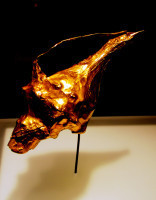



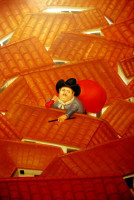

Blog post by Roderick Phillips, author of Weary Heart – a gut-wrenching, heart-wrenching, laugh-wrenching tale.
The post Museo del Oro, Bogota, Day 161 appeared first on Roderick Phillips.

